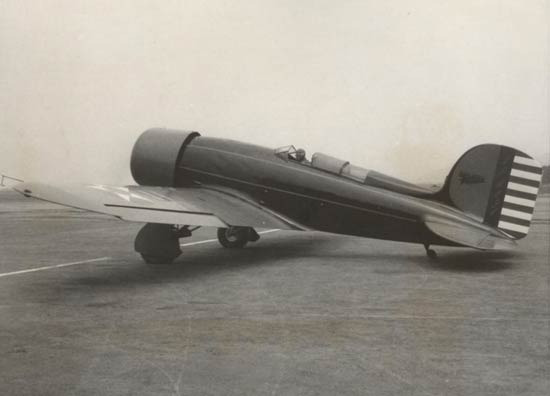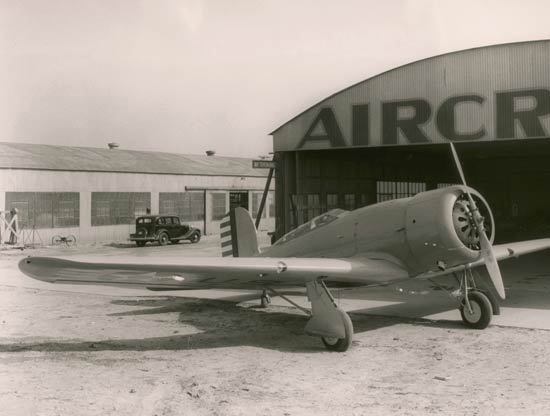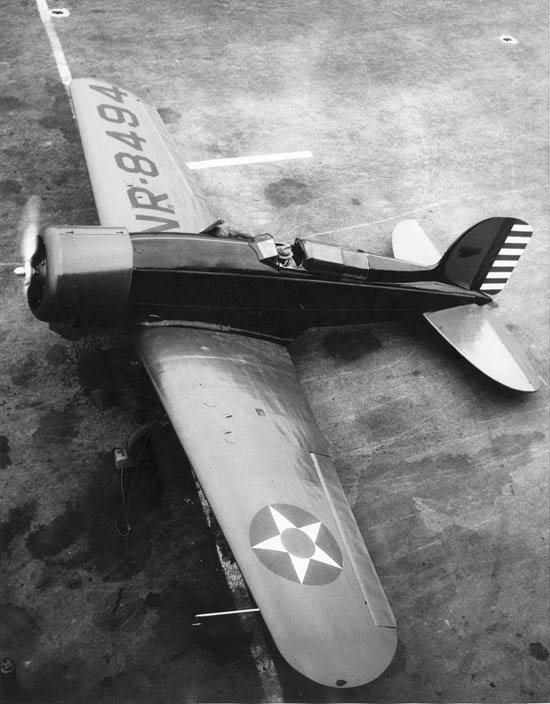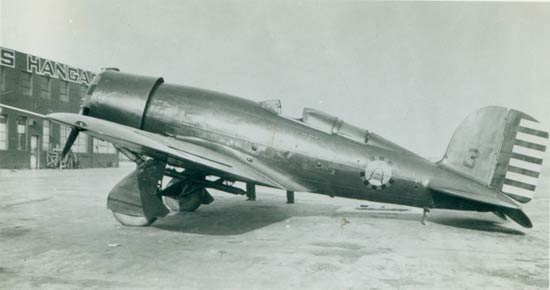|
LOCKHEED DL-2 SIRIUS (later Altair)
NR8494
COMMAND TRANSPORT
This airplane is a Lockheed Sirius Model DL-2 (S/N 165;
ATC #378) manufactured during August 1930 by Lockheed Aircraft
Corporation, Burbank, CA. It left the factory with
a Pratt & Whitney Wasp C engine (S/N 2036) of 420 HP. It
was a two-place airplane. Almost a year after it was manufactured,
it was sold to the U.S. Army Air Corps as officer transport.
I include an image of the NASM record, below, so you can
see what it was used for, and what its final disposition
was a scant 12 years and 1,000 flight hours after it was
born at Burbank.
NR8494 visited Tucson three times, on May 3rd, May 5th and
May 11, 1931. Each time it was flown by Captain Ira
C. Eaker. On May 3rd he carried Ennis Long as passenger.
They were southwest bound from Phoenix, AZ to San Diego,
CA. On the 5th he was solo, returning to San Diego from Phoenix.
On May 11th his passenger was Asst. Secretary of War Trubee
Davison, himself a pilot who landed at Tucson a few years
earlier on May 23, 1927. Although he didn’t write
it in the Register, Eaker was probably at Tucson on May 11th
with the group of twenty-five Army pilots in Douglas and
Curtiss aircraft who noted in the Remarks column of the Register, "In
on May 11th 1931, Enroute to Dayton, Ohio for Air Corps Exercises". They
were eastbound en
masse from San Diego, CA.
According to the NASM record, this airplane was registered NX and NC to Lockheed, then registered NR April 27, 1931. NR8494 was sold to the U.S.
Army Air Corps on July 29, 1931. It was assigned Air
Corps # A.C. 32-232. In Air Corps livery it was used
by General James E. Fechet and Asst. Secretary of War Davison
in observing 1931 Air Corps maneuvers (note this designation
is after its use for same back in May).
Photo, below, courtesy of Lockheed-Martin via Tim Kalina,
Chicago, IL. The Lockheed-Martin caption to this photos reads:
"Control Number: PC014-089
Negative Number: P-8493
Product: Altair
Company: Detroit Aircraft Corporation
Circa: 1932
Customer: USAAC
Keywords: aircraft, Altair, Detroit Aircraft Corporation,
DL-2A, ground, metal fuselage, nose left, transport, USAAC,
Y1C-23
Caption: Y1C-23 metal fuselage Altair DL-2A (c/n 165) operated
by the US Army Air Corps from 1931 until 1942."
Actually,
it was flown through 1938 and scrapped in 1942. Here,
the airplane is in its military livery and identified as
32-232.
For an unique and exciting view of NR8494 at Bolling
Field, Washington, DC, follow this link!
There is also an image of
this airplane at the NASA archives in the large Langley wind tunnel
in July, 1932. Click the thumbnail on that page and note
the comparative size of the person standing below the airplane
mount structure.
In the fall of 1931, Captain Eaker attempted a new coast-to-coast
record flight with the airplane. He made the flight,
but set no record. 32-232 was used as a command transport
by Capt. Eaker and Lt. Elwood R. Quesada. It was flown
to Panama.
It was converted to an Altair under Memo 2-386 as of October
17, 1931. It landed wheels up at least three times
(no record of who the pilot was). It was assigned
to Bolling Field, Washington, DC where it served from 1931-38. It
was condemned for further flight at Chanute Field, IL on
September 23, 1938. It had accumulated 1,075 flight
hours. It was scrapped in June 1942.
Image, below, is of the NASM record for 8494 in all its
civilian and military aliases (it wore NC, NX, NR and military
identification numbers). You can see from this record, when
the airplane landed at Tucson it was wearing its NR registration.
Eaker did not use an prefix when he signed the Register,
simply identifying it at all three visits as simply "8494".
You'll also note that it was, by the time of Eaker's landings,
converted to the Altair model. Here is a PDF file (68.2KB)
of the NASM record if you want a copy for yourself.
---o0o---
To recap, this airplane was originally registered NX8494 (9/11/30) and NC8494 (11/12/30) and NR8494 (4/27/31) by Lockheed. It became the Y1C-23 and assigned A.C. 32-232 when acquired by the USAAC (7/29/31). All the same airplane serial number.
Below are two additional photos of the Altair. The first one is from the collection of Roger Holden. Eaker is in the cockpit. Mr. Holden says, "Note the differences in the plane compared to the one you have posted. Besides a different exhaust system the plane carries slightly different trim. The cowling is solid yellow. The inset in the vertical stabilizer is yellow and there are two thin horizontal yellow stripes along the fuselage. These are the ‘T’ shape stringers that hold the metal fuselage panels." This photo is most likely earlier than the one at the top of this page.
Lockheed Y1C-23, A.C. 32-232
(Source: Holden)
Lockheed Y1C-23, A.C. 32-232, ca. 1935
 |
Image, below, is from Tim Kalina. Mr. Kalina says about the image, "This shows the Y1C-23 at the old Lockheed plant in Burbank just after rebuild summer in 1935. The wing had been extensively damaged in a wheels-up landing (this happened a number of times through mechanical and also pilot error-forgetting to extend the gear!). This is the new late-style wing with the angled wingtips, heavier horizontally mounted gear aero strut, and the narrower low-profile tires. The horizontal stabilizer and elevators are also the late-style with the external counter-balances on the elevators. The plane also got a new engine and propeller. It also got a new, different paint scheme per the current USAAC Mil standards. This would be A-N Yellow wings and tail-surfaces with True Blue fuselage and cowl."
Lockheed Y1C-23, A.C. 32-232, ca. 1935 (Source: Kalina)
 |
Mr. Kalina is sending the USAAC Aircraft History Cards on the Y1C-23. Look for them here soon. (They're added below, 10/28/08).
---o0o---
Below, as of October 28,2008, are two additional images of this airplane from Mr. Kalina. This is a clear, spectacular shot of the airplane with engine running. He says of the first one, "I recently obtained two old, original photos of Lockheed Y1C-23 (aka NR8494). The large, overhead shot is a news photo. This must have been taken when new at Lockheed. Note the unusual mix of civil and military markings."
NR8494, Date & Location Unknown
(Source: Kalina)
 |
Not only markings, but the canopy on the second one (curved), below, looks different than the one on the first (angular).
NR8494, Date & Location Unknown
(Source: Kalina)
 |
The coloration of this airplane is also of interest. Roger Holden says about it, "... I'm not 100% sure of its original colour scheme... What we CAN be sure of is that it had 3 colour schemes as follows:
1) The quasi-military scheme in which it was delivered (with the civil reg numbers).
2) The first Army repaint with the Bolling Field insignia (definitely Olive Drab fuselage/yellow wings).
3) The second Army repaint after rebuild with different wing (definitely Light Blue fuselage/yellow wings).
We can be sure of schemes 2 and 3,which were in accordance with the Army's precisely-defined instructions at the time.
When the plane was procured (scheme 1), the prevailing standard was o.d. fuselage/yellow wings. But these weren't 'standard' aircraft; rather, they were obtained as V.I.P. transports for carrying generals in the back seat (and a bit of record-breaking on the side). Army planes for use by senior officers (eg Fechet/Foulois/Westover) usually had
either a black or Insignia Blue fuselage. I don't think this was an official rule (hence the 2 colours being used), merely a personal preference."
Although the exact dates of these images are unknown, the top one was probably taken after April 27, 1931, as that is when the NR designation was assigned.
Regardless, further to the NASM record shown above, the final disposition of NR8494 (aka 32-232) is detailed in this PDF record (3.4MB; 6 pages)of maintenance for the airplane as documented on the USAAC Aircraft History Cards shared with us by Mr. Kalina. As you explore these records, you'll find that on April 4, 1938 at Spartanburg, SC, Col. Ira C. Eaker experienced, "Landing gear jammed in retracted position. Condemned for further flying service and returned to Chanute for ground instructional purposes per Chanute HQ 9-119 9/23/38".
---o0o---
UPLOADED: 05/01/06 REVISED: 02/14/08, 2/15/08, 10/28/08, 08/21/10
|
